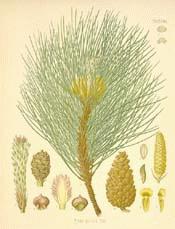
Botanical.com Home Page
PineBotanical: Various Species
|
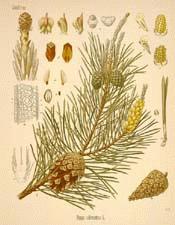
|
(Pinus sylvestris |
All the Pines yield resin in greater or smaller quantities, which is obtained by tapping the trees. The crude resin is almost entirely used for the distillation of Oil of Turpentine and Rosin, only small quantities being employed medicinally - for ointments, plasters, etc. When the Oil of Turpentine is entirely distilled off, the residuum is Rosin or Colophony, but when only part of the oil is extracted, the viscous mass remaining is known commercially as common Crude Turpentine.
Oil of Turpentine is a good solvent for many resins, wax, fats, caoutchouc, sulphur, and phosphorus, and is largely employed in making varnish, in oil-painting, etc. Medicinally, it is much employed in both general and veterinary practice as a rubefacient and vesicant, and is valuable as an antiseptic. It is used for horses and cattle internally as a vermifuge, and externally as a stimulant for rheumatic swellings, and for sprains and bruises, and to kill parasites.
Rosin is used not only by violinists, for rubbing their bows, but also in making sealing wax, varnish, and resinous soaps for sizing paper and papier maché and dressing hemp cordage, but one of its special uses is for making brewer's pitch for coating the insides of beer casks and for distilling resinous oils, when the pitch used by shoemakers is left as residuum. Pitch is also used in veterinary practice.
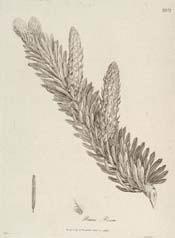
|
Click on graphic for larger image |
Tar is an impure turpentine, viscid and brown-black in colour, procured by destructive distillation from the roots of various coniferous trees, particularly from Pinus sylvestris. Tar is used medicinally, especially in veterinary practice, for its antiseptic, stimulant, diuretic and diaphoretic action. Tar-water is given to horses with chronic cough and used internally and externally as a cutaneous stimulant and antiseptic in eczema. Oil of Tar is used instead of Oil of Turpentine in the case of mange, etc.
A considerable industry has grown up in the United States in the distillation of Pine wood by means of steam under pressure. One of the products thus obtained, which has considerable commercial importance, is known as Pine Oil. It has a pleasant odour, resembling that of caraway or Juniper Oil, and has been largely used for making paints which dry without gloss and as a 'flatting' material. It flows well under the brush and is a powerful solvent, and is useful for emulsion paints such as are now employed for inside work.
Pine resins are largely employed by the soap-maker for the manufacture of brown soaps.
The trade in resins was for many years almost exclusively a French industry, and only in France were the Pine forests turned to account for the production of resin on a commercial scale. Now, however, Switzerland, Sweden, Russia and North America furnish quantities, though, from the point of view of quality, the Pines which flourish near Bordeaux furnish a resin still much in request, and the turpentine extracted therefrom is abundant and one of the best qualities produced.
---Medicinal Action and Properties---Rubefacient, diuretic, irritant. A valuable remedy in bladder, kidney, and rheumatic affections and diseases of the mucous membrane and respiratory complaints; externally in the form of liniment plasters and inhalants.
---Preparations and Dosages---Oil of Turpentine. Spirits of Turpentine, B.P., 2 to 10drops As a vermifuge, 2 to 4 drachms. Tar, B.P., Pin. Sylv. Tar, U.S.P., Pin. Palust. Ointment Tar, B.P. Syrup Tar, U.S.P., 1 drachm.
See TAMARAC.
[Top]
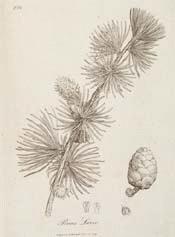
|
Click on graphic for larger image |
SPECIES OF PINES HAVING MEDICINAL PRODUCTS
Pinus balsamea. Abies canadensis. A. balsamea. Balsam Fir. Balm of Gilead Fir. Perusse. Hemlock Spruce.
Canada Turpentine. Pills for mucous discharge.
P. Canadensis. A. canadensis. Hemlock Spruce.
Pitch and Oil.
P. Cedrus of Mount Lebanon.
A false manna used in phthisis in Syria.
P. Cembra (Siberian Cedar or Tannenbaum). Europe and Asia.
Edible seeds eaten by Russians as nuts. Coniferin from the cambium.
P. Cubensis. Cuban Pine.
Turpentine.
P. Damaris. Agathis Damara.
Damara Turpentine that hardens into a hard rosin.
P. Densiflora. Japan.
An exudation called akamatsu. Timber.
P. Echinata. Short-leaved Pine.
Turpentine. Timber.
P. Gerardiana. Neosa Pine. N.W. India.
Edible seeds called neosa or chilgoza seeds.
P. Halepensis. Mediterranean countries.
Spirits of Turpentine.
P. Heterophylla. Eastern America.
Spirits of Turpentine. Timber.
P. Khasya. Burma.
Turpentine resembling French Oil.
P. Larix. Larix Europaea. A. larix. L. decidua. Larch.
Briançon manna, containing no mannite. Venice Turpentine.
See Pine (Larch)
P. Maritima. P. pinaster. Cluster Pine. Mediterranean countries.
Bordeaux Turpentine. Pitch. French Oil of Turpentine, 25 per cent.
P. Merkusii. Burma.
Turpentine resembling French Oil.
P. Microcarpa. P. pendula. L. Americana. Black or American Larch. Hackmatack. Tamarac.
A decoction of the bark used.
P. Mughus. Hungarian terebinth.
P. Nigra. Pieca Mariana. Black or Bog Spruce.
Decoction of young branches gives Essence of Spruce used for Spruce Beer.
P. Palustris. P. Australia. Long-leaved Pine. Yellow, Southern, Hard, Virginia.
Spirits of Turpentine, 17 per cent oil. Carpets woven from leaves.
P. Picea. A. pectinata. Picea vulgaris. P. abies. A. vulgaris. A. alba. Spruce Fir. Norway Spruce.
Strassbourg Turpentine. Térébinthine au citron.
P. Pinea. Mediterranean countries.
Edible seeds. 'Pignons' or 'Pinocchi.'
P. Ponderosa. Heavy Pine. California.
Exudation is almost pure heptane; a chief constituent of American petroleum. Timber.
P. Pumilio. P. montana.
Volatile Oil from the leaves. Oil of Dwarf Pine Needles. Oil of Pine.
P. Rigida. Pitch Pine.
Tar.
P. Roxburghii. Himalayas.
Spirits of Turpentine.
P. Sabiniana. Nut or Digger Pine.
Turpentine, the oil being called abietene. Edible seeds.
P. Scropica.
Occasionally its Turpentine is used for American Rosin.
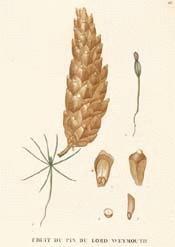
|
Click on graphic for larger image |
P. Strobus. P. alba. White Pine.
Coniferin from the Cambium Bark. Compound Syrup with Morphine. Timber.
See Pine, White
P. Succinifera. Extinct.
Fossil resin or amber.
P. Sylvestris. Scotch Pine or Fir. Norway Pine.
Spirits of Turpentine, 32 per cent of oil. Russian Turpentine. Finnan Turpentine is the oleoresin. Timber.
P. Toeda. Loblolly Pine. Old Field Pine. United States.
Occasionally its turpentine used for American rosin.
P. Teocoty. Mexican or Brea Turpentine.
P. Thunbergii. Japan.
Exudation called Kuromatsu. Timber.
[Top]
|
Purchase from Richters Seeds
Pine Nut (Pinus pinea) Seeds |
© Copyright Protected 1995-2025 Botanical.com
